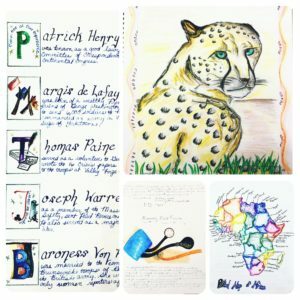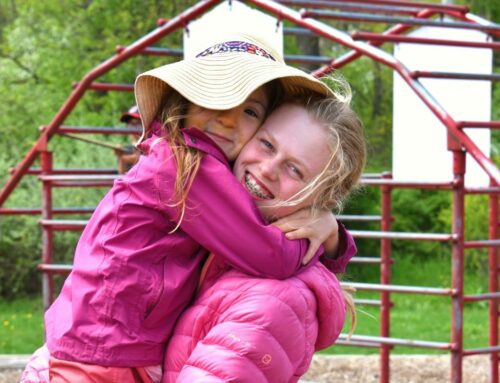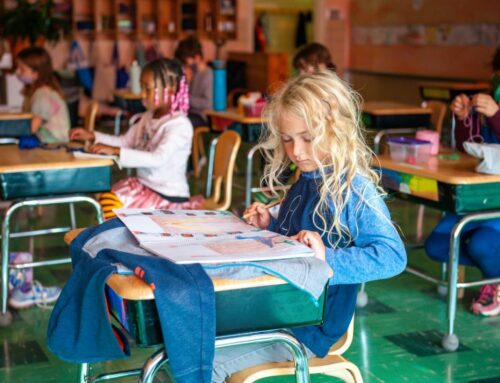To truly acquire knowledge, and not simply memorize it for an upcoming test, a student of any age needs time for that seed of knowledge to take root and grow. Waldorf education uses the block structure of learning to make sure that students have the time they need to experience true learning and find relevancy and interest in the topic at hand. We call this academic learning block Main

Lesson.
After a hearty morning recess and the morning class routine, children begin the 90-minute to two-hour learning period called Main Lesson, where subjects like reading, math, history and science are taught in the block method.
Teachers typically present new concepts in a three or four week blocks to provide an in-depth learning experience of a single subject. In a block system, students are immersed in one subject at a time in order to fully focus on the content area and gain a complete understanding before moving on to the next course of study.
This method helps students, who may not enjoy a particular subject, focus on improvement, since they cannot simply tune out during a 30 to 40-minute class each day, but are instead immersed in the topic for several weeks.
This method helps teachers use a multi-sensory and multi-activity learning approach because the time allotted allows them to engage the children with a wide variety of activities to help increase student motivation and interest in the topic at hand.
This method also makes little use of worksheets and there are no textbooks to be read. The teacher reads the source material and presents it to students in an engaging and relevant way. Skill practice comes in the form of hands- on, project and process-based learning versus memorization and mimicry.
While teachers ultimately decide when and how to present material, there is a typical three-pronged approach to each Main Lesson and a three-day approach to new material presented.
Each day’s lesson is structured to contain activities that typically begin with recitation, music, movement, and recall of the previous day’s lessons. After this, new material is presented through story and lecture, and then for the latter part of the lesson the newly presented material is worked on and practiced through a relevant activity.
While this is a typical structure of a Main Lesson block during thea day, the week itself leans into a structure as well. New material is often presented on a three-day cycle that begins with a focus on engaging storytelling and lecture. The following day focuses on recall of the previous day’s material and a deep dive into practical application of the topic, which is often done through hands-on activity. And finally, on the final day of a topic, the student practices recall again and composes and summarizes the material learned into their Main Lesson book.
Every Main Lesson features work in the Main Lesson book which is created by the student. The student writes and illustrates the lesson’s content into their books. This content consists of relevant illustrations, stories, notes, and summaries all written by hand. In the early grades, the students imitate the teacher in the creation of their main lesson book. In grades 3-5, the students help create the content of the main lesson book, as a class, with the teacher’s guidance. In middle school, or grades 6-8, the students take notes while the teacher lectures and they go over these notes individually with the teacher. When the content is has been checked by the teacher, the students are given more freedom within the creation of their books because the writing is their own along with the illustrations. This makes both the book and the content of the lesson their own. This brings personalization, beauty, joy, and relevancy to lessons.
For an example of possible Main Lesson structure and content, let’s consider an upper grades week in a math block. If the math block is focused on geometry and the week’s lesson is platonic solids, the teacher may begin the block that week with a story about Plato and his theory of forms. Students may open each day with a recorder song or scale from the era in which Plato lived. The teacher may engage students in the practice of drawing platonic solids.
As the week continues, the students will learn more details about platonic solids, such as their formulas through lecture, but also will recall what they learned and begin an in-depth project to create their own 3D models of platonic solids. Finally, the week ends with students presenting their model work to the class and writing and illustrating the details of the week’s lesson into their Main Lesson book.
Main Lesson, and the block style of learning, is a process-based learning method, used in many schools and universities throughout the world today. It is a meaningful alternative to results-based teaching that focuses on test results. Rudolf Steiner was an early adopter of the block and process method and believed this style of teaching gave students the time and space they needed to find meaning and purpose in their education. He also wanted to be sure each teacher had the time to engage a student’s head, heart, and hands, so that they could learn, and be inspired by, the material for a lifetime.


